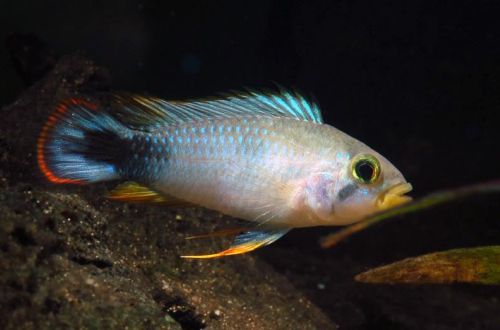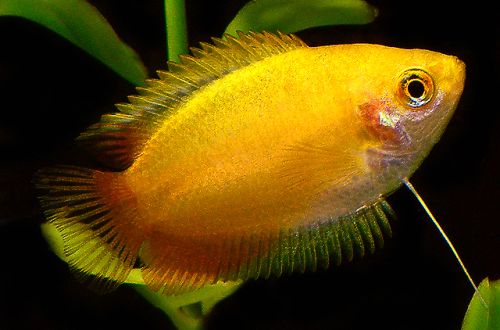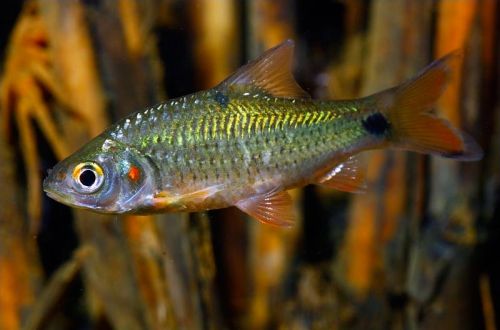
Azure cichlid
The Azure Cichlid, Blue Cichlid or Apistogramma Panduro, scientific name Apistogramma panduro, belongs to the Cichlidae family. Representative of South American cichlids. It is considered relatively unpretentious in content, perfectly compatible with other freshwater fish species, but intraspecific relationships are not so simple, more on that below.

Contents
Habitat
It comes from South America from the Loreto region – a region in the northeast of Peru. Found in the upper Amazon basin. Inhabits numerous rivers and streams flowing through tropical rainforest. The river bed is littered with branches, tree roots, fallen leaves, which, in the process of decomposition, release a large amount of tannins, giving the water a brown tint.
Brief information:
- The volume of the aquarium – from 60 liters.
- Temperature – 22-29°C
- Value pH — 4.0–6.5
- Water hardness – 0–5 GH
- Substrate type – sandy
- Lighting – subdued
- Brackish water – no
- Water movement is weak
- The size of the fish is 5–7 cm.
- Food – small sinking food from a variety of products
- Temperament – peaceful
- Keeping in a harem with one male and several females
Description

Adults reach a length of 5–7 cm. Males are larger. The color is dominated by blue shades, the tips of the fins are yellow. The tail has a red border. Females are not only inferior in size, but also differ in color and body pattern: there are pronounced black marks on a pale yellow background. The first is located in the middle of the body, the second runs diagonally across the head.
Food
In nature, it feeds on small invertebrates. In a home aquarium, the diet should also consist of protein-rich foods, such as live or frozen brine shrimp, daphnia, bloodworms. An excellent alternative can be dry food (in the form of flakes, granules) from well-known manufacturers.
Maintenance and care, arrangement of the aquarium
The optimal size of an aquarium for one or two fish starts from 50-60 liters. The design is arbitrary, however, Apistogramma Panduro will look more harmonious in an environment that resembles natural reservoirs. Therefore, if possible, it is worth using the following decor elements: sandy soil, several snags and live or artificial plants located in dense clusters. The lighting is subdued. If breeding is planned, then the design should provide for places for shelters – caves, grottoes, or place ordinary ceramic pots turned on their side, or hollow fragments of PVC pipes with a diameter of about 4–5 cm.
Adding dry leaves of some trees (beech, oak, Indian almond, etc.) will add naturalness to the design, as well as bring the composition of the water closer to that in which fish live in nature. In the process of decomposition, the leaves release tannins and along the way color the water in a characteristic brown color.
The long-term maintenance of this species of fish will require the aquarist to carry out regular maintenance of the aquarium in order to maintain stable water conditions within the acceptable range of hydrochemical values and to prevent excess concentrations of products of the nitrogen cycle (ammonia, nitrites, nitrates).
Behavior and Compatibility
Males can be quite aggressive towards relatives, especially during the spawning period. It is recommended to maintain a group of one male and several females – relevant for small aquariums. It is not uncommon for a male and a female to form a monogamous pair, which persists for a long time. Calmly relate to representatives of other species. Compatible with non-aggressive fish of comparable size.
Breeding / breeding
Under favorable conditions (suitable water composition, high quality food), spawning occurs regularly. The male is able to fertilize the clutches of several females, does not participate in the care of offspring. Females spawn in shelters, as noted above, these can be both decorated caves and ordinary pots. The entire incubation period and the first weeks after the appearance of fry, the female remains next to them. It is advisable to temporarily relocate the male because of his possible aggression.
Fish diseases
The main cause of diseases lies in the conditions of detention, if they go beyond the permissible range, then immunity suppression inevitably occurs and the fish becomes susceptible to various infections that are inevitably present in the environment. If the first suspicions arise that the fish is sick, the first step is to check the water parameters and the presence of dangerous concentrations of nitrogen cycle products. Restoration of normal/suitable conditions often promotes healing. However, in some cases, medical treatment is indispensable. Read more about symptoms and treatments in the Aquarium Fish Diseases section.





